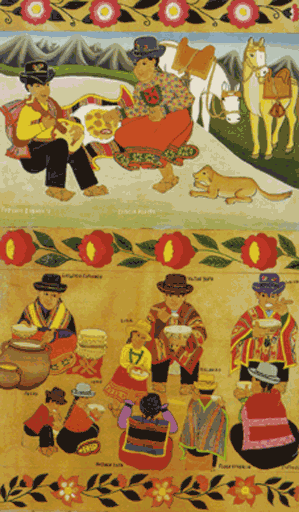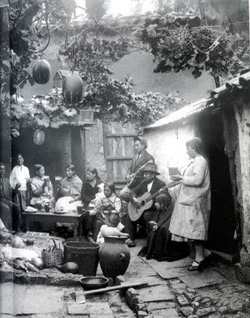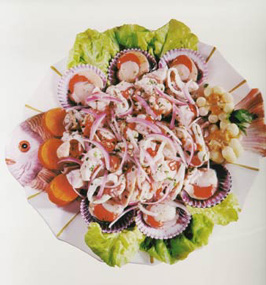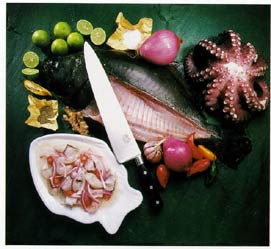

Peruvian cuisine is one of the best in South America and it's known not only for its exquisite taste, but also for its variety and ability to incorporate the influence from different times and cultures.
The Peruvian cuisine is an important expression of its own culture just as its ceramics, textiles, music and literature. Thanks to Peru's three regions and ocean there are an abundance of markets that can offer a variety of fresh ingredients that satisfy not only the housewife but also the most sophisticated chef.
The culinary history of the Peruvian food dates back to the Incas and pre-Incas with its maize, potatoes and spices that later was influenced by the arrival of the Spanish colonies, and throughout the years it incorporated the demands of the different migrations and "mestizajes". Such groups included Chinese, European, African and Japanese immigrants.
The Incas... In the Incas Chronicles, Garcilazo Inca de la Vega narrates the foods of the ancient Peruvians and their rituals. Garcilazo describes the Incas meals as being in abundance because it was served not only to the Inca but also to his extended families, guests and large number of servants. The most important meal of the day, not only for the Incas but also for all the ordinary people, was served in the morning between 8 and 9 and the only other meal was served at dusk.
It's known that the Inca had a group of chefs assigned to him but the concubines where the ones that cooked for him. It is also known that drinks where never mixed during the meals they where normally taken afterwards. One of the most important ingredients during Pre-Hispanic times was maize and it was prepared toasted or simply boiled in water and on special occasions it was prepared into bread and "humitas" (tamales).
Another basic ingredient of these cultures was the potato and it was cooked or roasted and used in stews. Also used were squash, a variety of beans, "oca" and yams. The meats that these ancient Peruvians ate were "huanaco", "pacollama", deer, roe deer and male fallow deer, also a variety of birds called "nunuma" that were very similar to the Spanish goose. Among the most known fruits the Incas grew were bananas, avocados, papayas, plums and giant pineapple (twice the size of the ones known by the Spaniards).
The most important seasoning used to prepare the meals was what today is known as "aji" and it used to be called "uchu" by the Incas or "pepper from the Indies" by the Spaniards. Aji even today is one of the most important ingredients used in the Peruvian kitchen. Another important component to pre-Hispanic Peruvian cuisine is the seafood and the foods from the coastal region. Fishing was an important source of food before the conquest. Around a third of the coastal population was dedicated to fishing and this was all possible thanks to the variety of fish characteristic of the Peruvian ocean.
Also important sources of food in the coastal region were the llama, Alpaca, guanaco, duck and in certain areas dog (even though the Incas would never eat dogs). The guinea pig was mainly consumed by the ordinary people and its skin was set to dry and later chopped and called then "charqui". This "charqui" was used to prepare soups and stews.
The food after the Conquest... After the arrival of the conquerors in 1533 a number of ingredients and culinary styles where brought from Europe and the rest of world that started the process of "mestizaje". Among these new ingredients which became part of the native recipes were cows, hens and rabbits. Wheat was also brought and it took three years of conservation before it was actually used to make bread.
Garcilazo Inca de la Vega narrates in his chronicles that later on the vine grapes and olives where also brought by Noble Spaniards. As far as fruits and vegetables, lettuce, eggplants, onions, spinach, asparagus, cilantro, parsley and figs, oranges, limes, peaches, apples and cherries were also brought from Europe.
And last but not least, sugar cane which made possible the vast variety of desserts later developed in the colony made mainly by the nuns at the convents and these convents would specialize and become famous on a particular dessert. During this period, many Spanish recipes incorporated native ingredients such as maize, yams, potatoes, yucca and bananas. But among the most important ones is "aji" that became the most characteristic ingredient in this new "Peruvian" cuisine.
The Peruvian food in the latest years...oriental influence One thing that surprises the tourist that visits Peru is the large amount of oriental restaurants. There are over 2000 Chinese restaurants called "chifas". Peru is by far the country with the most Chinese restaurants in Latin America. Between 1849 and 1874, 100,000 Chinese immigrants arrived in Peru. Right after this migration, the "fondas" or places where the Chinese used to eat were the first ones to appear around the Chinese neighborhoods. Later some restaurants started to open up but it was only 40 years ago that Chinese restaurants where opened in the residential areas and through out Peru. The food served in most of these restaurants is from the region of Canton, but in the latest years there are also foods from Beijing, Shanghai and Szechwan. Now days, every grocery market carries a section of Chinese ingredients that is mixed with the local ingredients and seafood from the Peruvian ocean, which creates the most exquisite plates.
There are several things to do when you travel to Peru—visit the archaeological sites, historical monuments, and travel through the different regions, but something special that Peru has to offer is its magnificent food...
See the special interest tours link for culinary tours to Peru.




Cultural Expeditions Peru offers:
Customized culinary group tours to Peru.
Travel to Peru's Spanish and Andean history, culture, and culinary arts.
Travel packages tailored to your interests in the culinary arts with expert knowledgeable trip leadership.
Contact us for customized cuisine tours to Peru.